CHAPTER 2 Operations with Rational Numbers and Introduction to Real Numbers
2.1 Visualize Fractions
Learning Objectives
By the end of this section, you will be able to:
- Find equivalent fractions
- Simplify fractions
- Multiply fractions
- Divide fractions
- Simplify expressions written with a fraction bar
- Translate phrases to expressions with fractions
Find Equivalent Fractions
Fractions are a way to represent parts of a whole. The fraction ![]() means that one whole has been divided into 3 equal parts and each part is one of the three equal parts. See (Figure 1). The fraction
means that one whole has been divided into 3 equal parts and each part is one of the three equal parts. See (Figure 1). The fraction ![]() represents two of three equal parts. In the fraction
represents two of three equal parts. In the fraction ![]() , the 2 is called the numerator and the 3 is called the denominator.
, the 2 is called the numerator and the 3 is called the denominator.
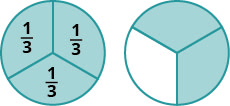
The circle on the left has been divided into 3 equal parts. Each part is ![]() of the 3 equal parts. In the circle on the right,
of the 3 equal parts. In the circle on the right, ![]() of the circle is shaded (2 of the 3 equal parts).
of the circle is shaded (2 of the 3 equal parts).
Fraction
A fraction is written ![]() , where
, where ![]() and
and
- a is the numerator and b is the denominator.
A fraction represents parts of a whole. The denominator b is the number of equal parts the whole has been divided into, and the numerator a indicates how many parts are included.
If a whole pie has been cut into 6 pieces and we eat all 6 pieces, we ate ![]() pieces, or, in other words, one whole pie.
pieces, or, in other words, one whole pie.

So ![]() . This leads us to the property of one that tells us that any number, except zero, divided by itself is 1
. This leads us to the property of one that tells us that any number, except zero, divided by itself is 1
Property of One
![]()
Any number, except zero, divided by itself is one.
If a pie was cut in ![]() pieces and we ate all 6, we ate
pieces and we ate all 6, we ate ![]() pieces, or, in other words, one whole pie. If the pie was cut into 8 pieces and we ate all 8, we ate
pieces, or, in other words, one whole pie. If the pie was cut into 8 pieces and we ate all 8, we ate ![]() pieces, or one whole pie. We ate the same amount—one whole pie.
pieces, or one whole pie. We ate the same amount—one whole pie.
The fractions ![]() and
and ![]() have the same value, 1, and so they are called equivalent fractions. Equivalent fractions are fractions that have the same value.
have the same value, 1, and so they are called equivalent fractions. Equivalent fractions are fractions that have the same value.
Let’s think of pizzas this time. (Figure 2) shows two images: a single pizza on the left, cut into two equal pieces, and a second pizza of the same size, cut into eight pieces on the right. This is a way to show that ![]() is equivalent to
is equivalent to ![]() . In other words, they are equivalent fractions.
. In other words, they are equivalent fractions.
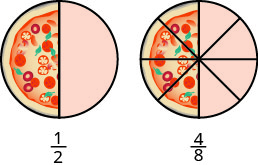
Since the same amount is of each pizza is shaded, we see that ![]() is equivalent to
is equivalent to ![]() . They are equivalent fractions.
. They are equivalent fractions.
Equivalent Fractions
Equivalent fractions are fractions that have the same value.
How can we use mathematics to change ![]() into
into ![]() How could we take a pizza that is cut into 2 pieces and cut it into 8 pieces? We could cut each of the 2 larger pieces into 4 smaller pieces! The whole pizza would then be cut into
How could we take a pizza that is cut into 2 pieces and cut it into 8 pieces? We could cut each of the 2 larger pieces into 4 smaller pieces! The whole pizza would then be cut into ![]() pieces instead of just 2. Mathematically, what we’ve described could be written like this as
pieces instead of just 2. Mathematically, what we’ve described could be written like this as ![]() . See (Figure 3).
. See (Figure 3).
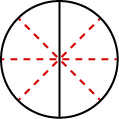
Cutting each half of the pizza into ![]() pieces, gives us pizza cut into 8 pieces:
pieces, gives us pizza cut into 8 pieces: ![]() .
.
This model leads to the following property:
Equivalent Fractions Property
If ![]() are numbers where
are numbers where ![]() , then
, then
![]()
If we had cut the pizza differently, we could get
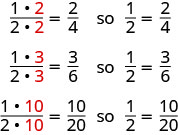
So, we say ![]() are equivalent fractions.
are equivalent fractions.
EXAMPLE 1
Find three fractions equivalent to ![]() .
.
To find a fraction equivalent to ![]() , we multiply the numerator and denominator by the same number. We can choose any number, except for zero. Let’s multiply them by 2, 3, and then 5.
, we multiply the numerator and denominator by the same number. We can choose any number, except for zero. Let’s multiply them by 2, 3, and then 5.

So, ![]() are equivalent to
are equivalent to ![]() .
.
TRY IT 1.1
Find three fractions equivalent to ![]() .
.
Show answer
![]() answers may vary
answers may vary
TRY IT 1.2
Find three fractions equivalent to ![]() .
.
Show answer
![]() answers may vary
answers may vary
Simplify Fractions
A fraction is considered simplified if there are no common factors, other than 1, in its numerator and denominator.
For example,
 is simplified because there are no common factors of 2 and 3.
is simplified because there are no common factors of 2 and 3. is not simplified because
is not simplified because  is a common factor of 10 and 15.
is a common factor of 10 and 15.
Simplified Fraction
A fraction is considered simplified if there are no common factors in its numerator and denominator.
The phrase reduce a fraction means to simplify the fraction. We simplify, or reduce, a fraction by removing the common factors of the numerator and denominator. A fraction is not simplified until all common factors have been removed. If an expression has fractions, it is not completely simplified until the fractions are simplified.
In Example 1, we used the equivalent fractions property to find equivalent fractions. Now we’ll use the equivalent fractions property in reverse to simplify fractions. We can rewrite the property to show both forms together.
Equivalent Fractions Property
If ![]() are numbers where
are numbers where ![]() ,
,
![]()
EXAMPLE 2
Simplify: ![]() .
.
| Rewrite the numerator and denominator showing the common factors. |  |
| Simplify using the equivalent fractions property. |
Notice that the fraction ![]() is simplified because there are no more common factors.
is simplified because there are no more common factors.
TRY IT 2.1
Simplify: ![]() .
.
Show answer
![]()
TRY IT 2.2
Simplify: ![]() .
.
Show answer
![]()
Sometimes it may not be easy to find common factors of the numerator and denominator. When this happens, a good idea is to factor the numerator and the denominator into prime numbers. Then divide out the common factors using the equivalent fractions property.
EXAMPLE 3
Simplify: ![]() .
.



TRY IT 3.1
Simplify: ![]() .
.
Show answer
![]()
TRY IT 3.2
Simplify: ![]() .
.
Show answer
![]()
We now summarize the steps you should follow to simplify fractions.
HOW TO: Simplify a Fraction
- Rewrite the numerator and denominator to show the common factors.
If needed, factor the numerator and denominator into prime numbers first. - Simplify using the equivalent fractions property by dividing out common factors.
- Multiply any remaining factors, if needed.
EXAMPLE 4
Simplify: ![]() .
.
Solution
| Rewrite showing the common factors, then divide out the common factors. |  |
| Simplify. |
TRY IT 4.1
Simplify: ![]() .
.
Show answer
![]()
TRY IT 4.2
Simplify: ![]() .
.
Show answer
![]()
Multiply Fractions
Many people find multiplying and dividing fractions easier than adding and subtracting fractions. So we will start with fraction multiplication.
We’ll use a model to show you how to multiply two fractions and to help you remember the procedure. Let’s start with ![]() .
.

Now we’ll take ![]() of
of ![]() .
.

Notice that now, the whole is divided into 8 equal parts. So ![]() .
.
To multiply fractions, we multiply the numerators and multiply the denominators.
Fraction Multiplication
If ![]() are numbers where
are numbers where ![]() , then
, then
![]()
To multiply fractions, multiply the numerators and multiply the denominators.
When multiplying fractions, the properties of positive and negative numbers still apply, of course. It is a good idea to determine the sign of the product as the first step. In Example 5, we will multiply negative and a positive, so the product will be negative.
EXAMPLE 5
Multiply: ![]() .
.
The first step is to find the sign of the product. Since the signs are the different, the product is negative.
| Determine the sign of the product; multiply. | |
| Are there any common factors in the numerator and the demoninator? No. |
TRY IT 5.1
Multiply: ![]() .
.
Show answer
![]()
TRY IT 5.2
Multiply: ![]() .
.
Show answer
![]()
When multiplying a fraction by an integer, it may be helpful to write the integer as a fraction. Any integer, a, can be written as ![]() . So, for example,
. So, for example, ![]() .
.
EXAMPLE 6
Multiply: ![]() .
.
Determine the sign of the product. The signs are the same, so the product is positive.
| Write |
|
| Multiply. | |
| Rewrite 20 to show the common factor 5 and divide it out. |  |
| Simplify. |
TRY IT 6.1
Multiply: ![]() .
.
Show answer
![]()
TRY IT 6.2
Multiply: ![]() .
.
Show answer
![]()
Divide Fractions
Now that we know how to multiply fractions, we are almost ready to divide. Before we can do that, that we need some vocabulary.
The reciprocal of a fraction is found by inverting the fraction, placing the numerator in the denominator and the denominator in the numerator. The reciprocal of ![]() is
is ![]() .
.
Notice that ![]() . A number and its reciprocal multiply to 1.
. A number and its reciprocal multiply to 1.
To get a product of positive 1 when multiplying two numbers, the numbers must have the same sign. So reciprocals must have the same sign.
The reciprocal of ![]() is
is ![]() , since
, since ![]() .
.
Reciprocal
The reciprocal of ![]() is
is ![]() .
.
A number and its reciprocal multiply to one ![]() .
.
To divide fractions, we multiply the first fraction by the reciprocal of the second.
Fraction Division
If ![]() are numbers where
are numbers where ![]() , then
, then
![]()
We need to say ![]() to be sure we don’t divide by zero!
to be sure we don’t divide by zero!
EXAMPLE 7
Divide: ![]() .
.
| To divide, multiply the first fraction by the reciprocal of the second. | |
| Multiply. |
TRY IT 7.1
Divide: ![]() .
.
Show answer
![]()
TRY IT 7.2
Divide: ![]() .
.
Show answer
![]()
EXAMPLE 8
Find the quotient: ![]() .
.
| To divide, multiply the first fraction by the reciprocal of the second. | |
| Determine the sign of the product, and then multiply.. | |
| Rewrite showing common factors. |  |
| Remove common factors. | |
| Simplify. |
TRY IT 8.1
Find the quotient: ![]() .
.
Show answer
![]()
TRY IT 8.2
Find the quotient: ![]() .
.
Show answer
![]()
There are several ways to remember which steps to take to multiply or divide fractions. One way is to repeat the call outs to yourself. If you do this each time you do an exercise, you will have the steps memorized.
- “To multiply fractions, multiply the numerators and multiply the denominators.”
- “To divide fractions, multiply the first fraction by the reciprocal of the second.”
Another way is to keep two examples in mind:
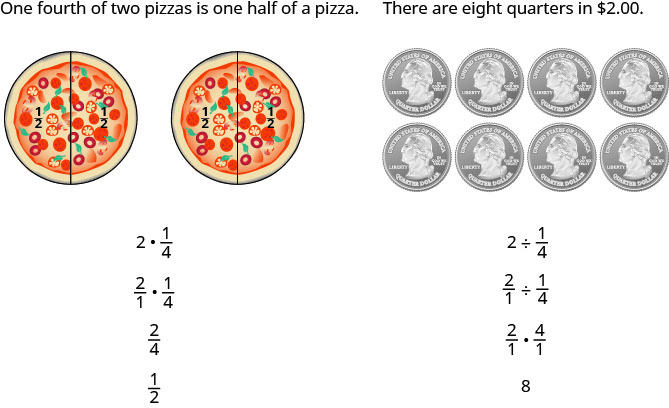
The numerators or denominators of some fractions contain fractions themselves. A fraction in which the numerator or the denominator is a fraction is called a complex fraction.
Complex Fraction
A complex fraction is a fraction in which the numerator or the denominator contains a fraction.
Some examples of complex fractions are:
![]()
To simplify a complex fraction, we remember that the fraction bar means division. For example, the complex fraction ![]() means
means ![]() .
.
EXAMPLE 9
Simplify: ![]() .
.
| Rewrite as division. | |
| Multiply the first fraction by the reciprocal of the second. | |
| Multiply. | |
| Look for common factors. |  |
| Divide out common factors and simplify. |
TRY IT 9.1
Simplify: ![]() .
.
Show answer
![]()
TRY IT 9.2
Simplify: ![]() .
.
Show answer
![]()
EXAMPLE 10
Simplify: ![]() .
.
| Rewrite as division. | |
| Multiply the first fraction by the reciprocal of the second. | |
| Multiply. | |
| Look for common factors. |  |
| Divide out common factors and simplify. |
TRY IT 10.1
Simplify: ![]() .
.
Show answer
![]()
TRY IT 10.2
Simplify: ![]() .
.
Show answer
![]()
Simplify Expressions with a Fraction Bar
The line that separates the numerator from the denominator in a fraction is called a fraction bar. A fraction bar acts as grouping symbol. The order of operations then tells us to simplify the numerator and then the denominator. Then we divide.
To simplify the expression ![]() , we first simplify the numerator and the denominator separately. Then we divide.
, we first simplify the numerator and the denominator separately. Then we divide.
HOW TO: Simplify an Expression with a Fraction Bar
- Simplify the expression in the numerator. Simplify the expression in the denominator.
- Simplify the fraction.
EXAMPLE 11
Simplify: ![]() .
.
| Use the order of operations to simpliy the numerator and the denominator. | |
| Simplify the numerator and the denominator. | |
| Simplify. A negative divided by a positive is negative. |
TRY IT 11.1
Simplify: ![]() .
.
Show answer
![]()
TRY IT 11.2
Simplify: ![]() .
.
Show answer
![]()

Placement of Negative Sign in a Fraction
For any positive numbers a and b,
![]()
EXAMPLE 12
Simplify: ![]() .
.
| Multiply. | |
| Simplify. | |
| Divide. |
TRY IT 12.1
Simplify: ![]() .
.
Show answer
4
TRY IT 12.2
Simplify: ![]() .
.
Show answer
2
Translate Phrases to Expressions with Fractions
Now that we have done some work with fractions, we are ready to translate phrases that would result in expressions with fractions.
The English words quotient and ratio are often used to describe fractions. Remember that “quotient” means division. The quotient of ![]() and
and ![]() is the result we get from dividing
is the result we get from dividing ![]() by
by ![]() , or
, or ![]() .
.
EXAMPLE 13
Translate the English phrase into an algebraic expression: the quotient of the difference of m and n, and p.
We are looking for the quotient of the difference of m and n, and p. This means we want to divide the difference of ![]() .
.
TRY IT 13.1
Translate the English phrase into an algebraic expression: the quotient of the difference of a and b, and cd.
Show answer
![]()
TRY IT 13.2
Translate the English phrase into an algebraic expression: the quotient of the sum of ![]() and
and ![]() , and
, and ![]()
Show answer
![]()
Key Concepts
- Equivalent Fractions Property: If
 are numbers where
are numbers where  , then
, then
 and
and  .
. - Fraction Division: If
 are numbers where
are numbers where  , then
, then  . To divide fractions, multiply the first fraction by the reciprocal of the second.
. To divide fractions, multiply the first fraction by the reciprocal of the second. - Fraction Multiplication: If
 are numbers where
are numbers where  , then
, then  . To multiply fractions, multiply the numerators and multiply the denominators.
. To multiply fractions, multiply the numerators and multiply the denominators. - Placement of Negative Sign in a Fraction: For any positive numbers
 ,
,  .
. - Property of One:
 Any number, except zero, divided by itself is one.
Any number, except zero, divided by itself is one. - Simplify a Fraction
- Rewrite the numerator and denominator to show the common factors. If needed, factor the numerator and denominator into prime numbers first.
- Simplify using the equivalent fractions property by dividing out common factors.
- Multiply any remaining factors.
- Simplify an Expression with a Fraction Bar
- Simplify the expression in the numerator. Simplify the expression in the denominator.
- Simplify the fraction.
Glossary
- complex fraction
- A complex fraction is a fraction in which the numerator or the denominator contains a fraction.
- denominator
- The denominator is the value on the bottom part of the fraction that indicates the number of equal parts into which the whole has been divided.
- equivalent fractions
- Equivalent fractions are fractions that have the same value.
- fraction
- A fraction is written
 , where
, where 
 is the numerator and
is the numerator and  is the denominator. A fraction represents parts of a whole. The denominator
is the denominator. A fraction represents parts of a whole. The denominator  is the number of equal parts the whole has been divided into, and the numerator
is the number of equal parts the whole has been divided into, and the numerator  indicates how many parts are included.
indicates how many parts are included.
- numerator
- The numerator is the value on the top part of the fraction that indicates how many parts of the whole are included.
- reciprocal
- The reciprocal of
 is
is  . A number and its reciprocal multiply to one:
. A number and its reciprocal multiply to one:  .
.
- simplified fraction
- A fraction is considered simplified if there are no common factors in its numerator and denominator.
Practice Makes Perfect
Find Equivalent Fractions
In the following exercises, find three fractions equivalent to the given fraction. Show your work, using figures or algebra.
| 1. |
2. |
| 3. |
4. |
Simplify Fractions
In the following exercises, simplify.
| 5. |
6. |
| 7. |
8. |
| 9. |
10. |
| 11. |
12. |
| 13. |
14. |
Multiply Fractions
In the following exercises, multiply.
| 15. |
16. |
| 17. |
18. |
| 19. |
20. |
| 21. |
22. |
| 23. |
24. |
| 25. |
26. |
| 27. |
28. |
| 29. |
30. |
Divide Fractions
In the following exercises, divide.
| 31. |
32. |
| 33. |
34. |
| 35. |
36. |
| 37. |
38. |
| 39. |
40. |
| 41. |
42. |
| 43. |
44. |
In the following exercises, simplify.
| 45. |
46. |
| 47. |
48. |
| 49. |
50. |
Simplify Expressions Written with a Fraction Bar
In the following exercises, simplify.
| 51. |
52. |
| 53. |
54. |
| 55. |
56. |
| 57. |
58. |
| 59. |
60. |
| 61. |
62. |
| 63. |
64. |
| 65. |
66. |
| 67. |
68. |
| 69. |
70. |
Translate Phrases to Expressions with Fractions
In the following exercises, translate each English phrase into an algebraic expression.
| 71. the quotient of r and the sum of s and 10 | 72. the quotient of A and the difference of 3 and B |
| 73. the quotient of the difference of |
74. the quotient of the sum of |
Everyday Math
| 75. Baking. A recipe for chocolate chip cookies calls for |
76. Baking. Nina is making 4 pans of fudge to serve after a music recital. For each pan, she needs |
| 77. Portions Don purchased a bulk package of candy that weighs |
78. Portions Kristen has |
Writing Exercises
| 79. Rafael wanted to order half a medium pizza at a restaurant. The waiter told him that a medium pizza could be cut into 6 or 8 slices. Would he prefer 3 out of 6 slices or 4 out of 8 slices? Rafael replied that since he wasn’t very hungry, he would prefer 3 out of 6 slices. Explain what is wrong with Rafael’s reasoning. | 80. Give an example from everyday life that demonstrates how |
| 81. Explain how you find the reciprocal of a fraction. | 82. Explain how you find the reciprocal of a negative number. |
Answers
| 1. |
3. |
5. |
| 7. |
9. |
11. |
| 13. |
15. |
17. |
| 19. |
21. |
23. |
| 25. |
27. 9n | 29. |
| 31. |
33. |
35. |
| 37. |
39. |
41. |
| 43. |
45. |
47. |
| 49. |
51. |
53. |
| 55. 0 | 57. |
59. |
| 61. |
63. |
65. |
| 67. |
69. |
71. |
| 73. |
75. a) |
77. 20 bags |
| 79. Answers may vary. | 81. Answers may vary. |
Attributions
This chapter has been adapted from “Visualize Fractions” in Elementary Algebra (OpenStax) by Lynn Marecek and MaryAnne Anthony-Smith, which is under a CC BY 4.0 Licence. Adapted by Izabela Mazur. See the Copyright page for more information.

